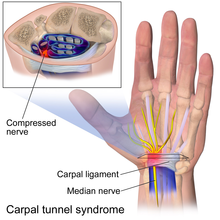Carpel Tunnel Syndrome.
What is Carpel Tunnel Syndrome?
Carpel Tunnel Syndrome (CTS) happens when the median nerve gets compressed in the carpel
tunnel in the wrist. The carpel tunnel is a space in the wrist between a group of small bones (the
carpel bones) and a ligament called the retinaculum. The tendons that attach the forearm muscles
to the fingers run through this tunnel, as does the median nerve which provides the sense of
feeling to the thumb, index and middle finger. The median nerve also helps to control the small
muscles at the base of the thumb. While the exact mechanism of CTS is not entirely understood,
there are common factors which predispose people to developing CTS. These factors include
– Injury to the wrist such as facture which results in swelling and an increase in fluid in the
carpel tunnel. This increase in fluid then irritates and compresses the median nerve.
– Pregnancy where there is increased fluid in the body and swelling of blood vessels, again
leading to compression of the median nerve.
– Conditions such as rheumatoid arthritis, hypothyroidism and obesity have also been
shown to increase the likelihood of developing CTS.
Symptoms of CTS
The most common symptom of CTS is pins and needles in the thumb, index and middle finger.
There may also be numbness in this area and pain in the hand. In severe cases of CTS there may
also be a loss of grip strength and wasting of the muscles at the base of the thumb.
Symptoms of CTS vary from person to person and can range from mild to severe. Sometimes
CTS is bilateral meaning it affects both hands – typically one hand is worse than the other.
Symptoms can also be worse at night due to a lack of movement at the wrist resulting in an
accumulation of fluid / swelling in the area.
How do I know if I have CTS?
Usually your history of symptoms is enough to diagnose CTS. In severe causes ultrasound or
MRI of the wrist / upper limb may also be useful in diagnosis. A nerve conduction test on the
median nerve may also be done in order to diagnose CTS.
What are the treatment options for CTS?
In some mild cases CTS can improve on its own. In moderate to severe cases of CTS there are
several treatment options which can help reduce symptoms associated with CTS. These include
– Prescription of anti-inflammatory and pain relief medication
– A wrist splint that can be removed during the day and worn at night
– A steroid injection into the carpel tunnel
– Physiotherapy for the prescription of appropriate home exercises including nerve gliding
exercises – we will go through these in more detail in next weeks blog post!
– Addressing lifestyle factors such as weight loss and ceasing smoking
Surgery may be required in severe cases of CTS. The operation is usually done under
anaesthetic and involves cutting the ligament over the front of the wrist to ease the
pressure on the median nerve.
How can physiotherapy help?
If you suspect you might have CTS it is always sensible to have a thorough assessment done to
confirm or negate the diagnosis. Physiotherapy is useful in CTS to reduce inflammation in the
carpel tunnel, improve movement of the wrist and to help settle irritation of the median nerve. If
you have any wasting of the thumb muscles or loss of power in the hand it is always best to see
your GP first. For further information on physiotherapy treatment for CTS, stay tuned for next weeks blog post.


